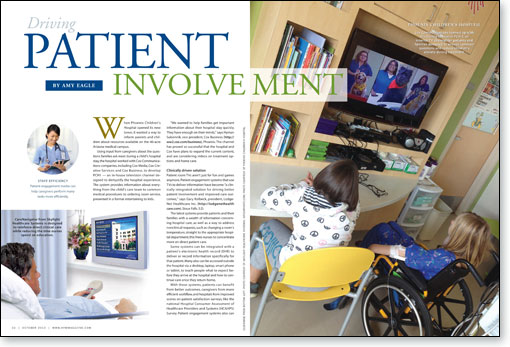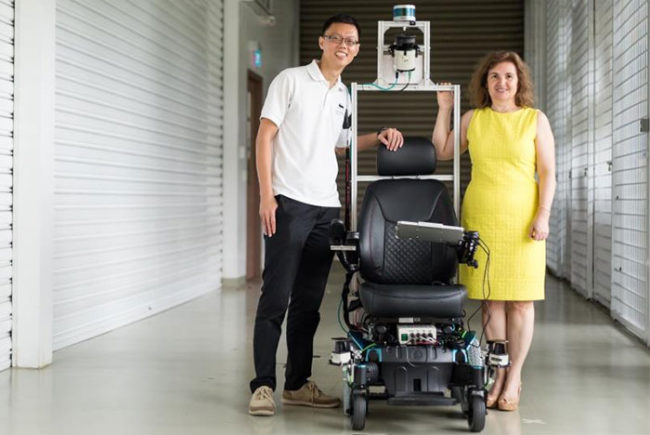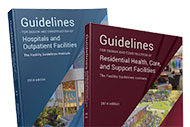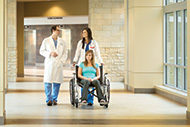
Click the above image for a PDF download
When Phoenix Children's Hospital opened its new tower, it wanted a way to inform parents and children about resources available on the 40-acre Arizona medical campus.
Using input from caregivers about the questions families ask most during a child's hospital stay, the hospital worked with Cox Communications companies, including Cox Media, Cox Creative Services and Cox Business, to develop PCH1 — an in-house television channel designed to demystify the hospital experience. The system provides information about everything from the child's care team to common medical procedures to ordering room service, presented in a format entertaining to kids.
"We wanted to help families get important information about their hospital stay quickly. They have enough on their minds," says Hyman Sukiennik, vice president, Cox Business (http://ww2.cox.com/business), Phoenix. The channel has proved so successful that the hospital and Cox have plans to expand the current content, and are considering videos on treatment options and home care.
Clinically driven solution
Patient room TVs aren't just for fun and games anymore. Patient engagement systems that use TVs to deliver information have become "a clinically integrated solution for driving better patient involvement and improved care outcomes," says Gary Kolbeck, president, LodgeNet Healthcare Inc. (http://lodgenethealthcare.com), Sioux Falls, S.D.
The latest systems provide patients and their families with a wealth of information concerning hospital care, as well as a way to address nonclinical requests, such as changing a room's temperature, straight to the appropriate hospital department; this frees nurses to concentrate more on direct patient care.
Some systems can be integrated with a patient's electronic health record (EHR) to deliver or record information specifically for that patient. Many also can be accessed outside the hospital via a desktop, laptop, smart phone or tablet, to teach people what to expect before they arrive at the hospital and how to continue care once they return home.
With these systems, patients can benefit from better outcomes, caregivers from more efficient workflow, and hospitals from improved scores on patient satisfaction surveys, like the national Hospital Consumer Assessment of Healthcare Providers and Systems (HCAHPS) Survey. Patient engagement systems also can help hospitals earn incentive payments from the Centers for Medicare & Medicaid Services, both for demonstrating meaningful use of EHRs and for meeting the quality measures of the Hospital Value-Based Purchasing Program established by the Affordable Care Act.
"With the new era of value-based purchasing and accountable care, hospitals understand that they are responsible for their patients after they leave the facility," says Darrell Atkin, director of marketing, Skylight Healthcare Systems Inc. (www.skylight.com), San Diego.
Reinforcing clinical care
Skylight's CareNavigator is designed to reinforce direct clinical care, not replace it, Atkin says. But he notes patient engagement systems like CareNavigator have been shown to decrease the time required for nurses to deliver patient education from 19 minutes to three minutes, with an 80 percent reduction in the number of times nurses need to repeat an educational session. "Patients are empowered to do it by themselves because they have easy access to it over the in-room TV," he says.
Skylight case studies show CareNavigator has helped hospitals to reduce patient fall rates, dramatically increase flu and pneumonia vaccination rates, and raise HCAHPS scores for communication, cleanliness, pain indication and noise at night.
Improved outcomes
Using LodgeNet's interactive eSuite system, patients can, for example, view preoperative videos at home, obtain information about their daily schedule while hospitalized, and follow up with disease management strategies once discharged. The system can be integrated with EHRs and tied directly to provider order entry, allowing physicians to prescribe specific educational content for their patients. When patients understand the information and their role in their recovery, they are more likely to participate, ask questions and change behaviors that evidence has shown to drive outcomes, Kolbeck says.
Discharge instructions and reminders can be sent to the patient's home computer or smart phone, ensuring that this critical information does not get lost in transition. Less paperwork also can mean less cost. NorthShore University HealthSystem, a four-hospital system in suburban Chicago, reports an initial savings of $250,000 in printing costs with the use of its LodgeNet system.
Optimal recovery
TeleHealth Services (www.telehealth.com), Raleigh, N.C., has taken a unique approach to providing education throughout the recovery continuum. Their TIGR and iTigr interactive patient education systems provide the inpatient education and information, while their at-home application is accessed via a Web portal developed by Emmi Solutions (www.emmisolutions.com), Chicago. Patients receive a user name and password during preadmission and remain in the system post-discharge, while providing access to the patient's education and care plan at any point in the recovery continuum.
"You're looking at the patient journey through the recovery process," says Matt Barker, vice president of marketing, TeleHealth. Through ongoing contact with patients — medication reminders, information about rehabilitation, peer support and so on — the hospital can help patients to achieve optimal recovery and avoid readmission. "You can see where that would really aid in patient retention, to have that sort of service provided to you during a rough period," Barker says.
TeleHealth helped Kaiser Permanente Panorama City (Calif.) Hospital lower cardiac and pneumonia readmission rates more than six percent. And after an infant cardiopulmonary resuscitation video was made available for viewing on demand through the TIGR system installed at Elmhurst (N.Y.) Hospital Center, two mothers saved their babies' lives with what they learned.
Actionable data
Interactive patient care systems by GetWellNetwork (http://getwellnetwork.com), Bethesda, Md., can integrate with EHRs to provide actionable data to patients and caregivers, like information on prescribed medications or a patient's fall risk score. By overlaying content on top of whatever TV channel a patient is watching, the system enables patients to respond quickly and easily to automated prompts.
GetWellNetwork's Patient Pathways are designed to address specific aspects of a hospital stay or condition, such as discharge planning, pain management, pediatric asthma or preventing heart failure readmissions.
"We have done so much research in the industry around evidence-based protocols and care plans, and they're terrific — it's just that we're not using them," says Michael O'Neil Jr., founder and chief executive officer, GetWellNetwork. "We need to find a way to further activate and involve patients. Interactive patient care is one of the solution sets."
David B. Nash, M.D., dean of the Jefferson School of Population Health at Thomas Jefferson University, Philadelphia, has studied the use of GetWellNetwork with congestive heart failure patients.
"We have solid evidence that it reduces readmissions and reduces unnecessary emergency room visits at a significant level," he says. "When patients are engaged in their care and get very good communication, they can improve their own outcomes."





